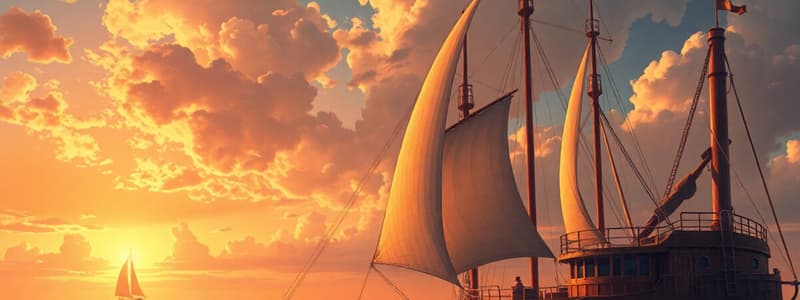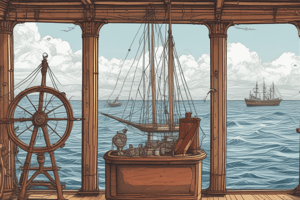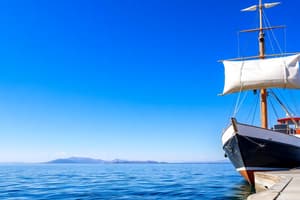Podcast
Questions and Answers
What is the main purpose of a GPS in modern navigation?
What is the main purpose of a GPS in modern navigation?
- To provide real-time location data (correct)
- To track maritime weather conditions
- To communicate with other vessels
- To provide alternative routes
What is a significant limitation of relying solely on GPS for navigation?
What is a significant limitation of relying solely on GPS for navigation?
- It may experience signal interference or equipment failure (correct)
- It is immune to signal loss under any conditions
- It can easily pinpoint the ship's exact location
- It requires constant updates from satellites
In which scenario would a navigator primarily rely on dead reckoning?
In which scenario would a navigator primarily rely on dead reckoning?
- When GPS systems fail or are unavailable (correct)
- When sailing in shallow waters
- When navigating in foggy conditions
- When entering busy ports
Which aspect must be assumed about a ship's movement when utilizing the bow and beam bearing method?
Which aspect must be assumed about a ship's movement when utilizing the bow and beam bearing method?
If the height of the observer's eye is 5 meters and the height of the light is 25 meters, what is the approximate geographical range of the light?
If the height of the observer's eye is 5 meters and the height of the light is 25 meters, what is the approximate geographical range of the light?
What effect does a southerly drift of 1.5 knots have on the intended course of a ship traveling west?
What effect does a southerly drift of 1.5 knots have on the intended course of a ship traveling west?
Which of the following best describes the estimated position after 2 hours if navigating at 12 knots with a southerly drift?
Which of the following best describes the estimated position after 2 hours if navigating at 12 knots with a southerly drift?
What information does a navigation plot typically provide regarding ship positioning?
What information does a navigation plot typically provide regarding ship positioning?
What is the primary purpose of using dead reckoning in navigation?
What is the primary purpose of using dead reckoning in navigation?
When using the bow and beam bearing method, what is essential to determine your position accurately?
When using the bow and beam bearing method, what is essential to determine your position accurately?
How does a set of 000° affect a vessel heading due north?
How does a set of 000° affect a vessel heading due north?
If a vessel is set 3 nautical miles to the north over a period, what is the drift involved at a speed of 3 knots?
If a vessel is set 3 nautical miles to the north over a period, what is the drift involved at a speed of 3 knots?
What is the estimated position (EP) affected by when calculating a vessel's position?
What is the estimated position (EP) affected by when calculating a vessel's position?
What is the result of a vessel traveling on a course of 045° at 15 knots for 2 hours while being set 3 nautical miles north?
What is the result of a vessel traveling on a course of 045° at 15 knots for 2 hours while being set 3 nautical miles north?
Which method would best assist a navigator in countering set and drift effects?
Which method would best assist a navigator in countering set and drift effects?
What will happen to a ship heading due south that experiences a current setting it to the west at 3 knots?
What will happen to a ship heading due south that experiences a current setting it to the west at 3 knots?
What is the term for the maximum distance at which a light can be seen under present visibility conditions?
What is the term for the maximum distance at which a light can be seen under present visibility conditions?
How can set and drift be corrected when plotting a course?
How can set and drift be corrected when plotting a course?
What is a major limitation of dead reckoning during prolonged voyages?
What is a major limitation of dead reckoning during prolonged voyages?
In the bow and beam bearing method, what is the primary advantage?
In the bow and beam bearing method, what is the primary advantage?
What tool is primarily utilized for measuring distance from a known point when plotting a position?
What tool is primarily utilized for measuring distance from a known point when plotting a position?
How does a running fix enhance the accuracy of a ship's position?
How does a running fix enhance the accuracy of a ship's position?
What happens when a light is first sighted as a ship approaches?
What happens when a light is first sighted as a ship approaches?
What is estimated position (EP) primarily based on?
What is estimated position (EP) primarily based on?
Flashcards
GPS Purpose
GPS Purpose
Provides real-time location data using satellite signals.
GPS Limitation
GPS Limitation
GPS signals can be blocked or the equipment can fail, leading to loss of navigational data.
Dead Reckoning Use
Dead Reckoning Use
A navigator would primarily rely on dead reckoning when GPS systems are unavailable.
Bow and Beam Assumption
Bow and Beam Assumption
Signup and view all the flashcards
Geographical Range
Geographical Range
Signup and view all the flashcards
Southerly Drift Effect
Southerly Drift Effect
Signup and view all the flashcards
Estimated Position with Drift
Estimated Position with Drift
Signup and view all the flashcards
Navigation Plot
Navigation Plot
Signup and view all the flashcards
Dead Reckoning Purpose
Dead Reckoning Purpose
Signup and view all the flashcards
Bow and Beam Essentials
Bow and Beam Essentials
Signup and view all the flashcards
Set of 000° Effect
Set of 000° Effect
Signup and view all the flashcards
Vessel Set
Vessel Set
Signup and view all the flashcards
Estimated Position (EP)
Estimated Position (EP)
Signup and view all the flashcards
Course and Set Effect
Course and Set Effect
Signup and view all the flashcards
Countering Set and Drift
Countering Set and Drift
Signup and view all the flashcards
Current Setting West
Current Setting West
Signup and view all the flashcards
Maximum Visible Distance
Maximum Visible Distance
Signup and view all the flashcards
Correcting Set and Drift
Correcting Set and Drift
Signup and view all the flashcards
Dead Reckoning Limitation
Dead Reckoning Limitation
Signup and view all the flashcards
Bow and Beam Advantage
Bow and Beam Advantage
Signup and view all the flashcards
Distance Measuring Tool
Distance Measuring Tool
Signup and view all the flashcards
Running Fix Accuracy
Running Fix Accuracy
Signup and view all the flashcards
First Light Sighting
First Light Sighting
Signup and view all the flashcards
Estimated Position (EP Basis)
Estimated Position (EP Basis)
Signup and view all the flashcards
Study Notes
Estimated Position (EP)
- An approximate position based on available data.
Set and Drift
- Set: The direction a current pushes a vessel.
- Drift: The speed at which a current pushes a vessel.
- Correcting for set and drift: Adjust the ship's course to compensate for the current's push.
Dead Reckoning (DR)
- A method for determining a ship's position based on its last known position, course, and speed.
- Does not account for wind or current, leading to errors over time.
Bow and Beam Bearing
- A method for finding a ship's position by taking two bearings of a landmark.
- The ship's course and speed are assumed to be constant between the two bearings.
Running Fix
- Improves the accuracy of a ship's position by providing multiple data points over time.
Geographical Range of a Light
- The maximum distance at which a light can be seen under present visibility conditions.
- Calculated using: Range=2.08 √h+2.08 √H (h is the height of the observer's eye, and H is the height of the light).
GPS
- Provides real-time location data.
- Limitations: Signal interference or equipment failure.
Luminous Range
- The term used to describe the maximum distance at which a light can be seen under present visibility conditions.
Studying That Suits You
Use AI to generate personalized quizzes and flashcards to suit your learning preferences.





